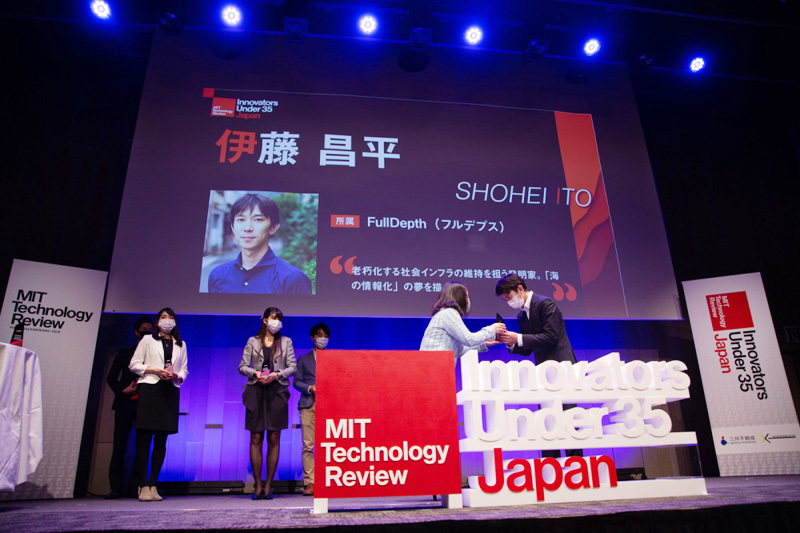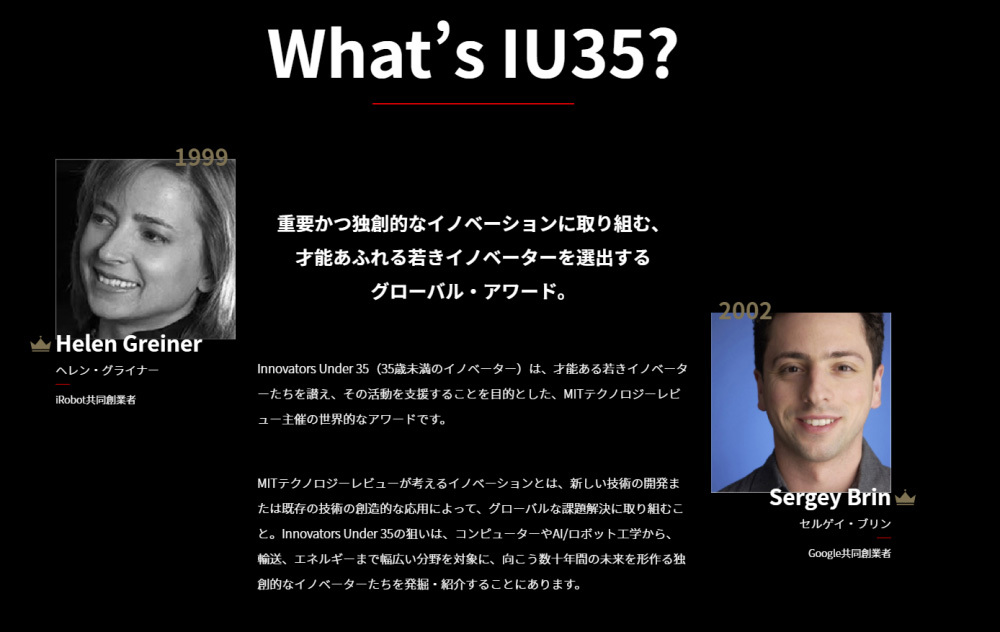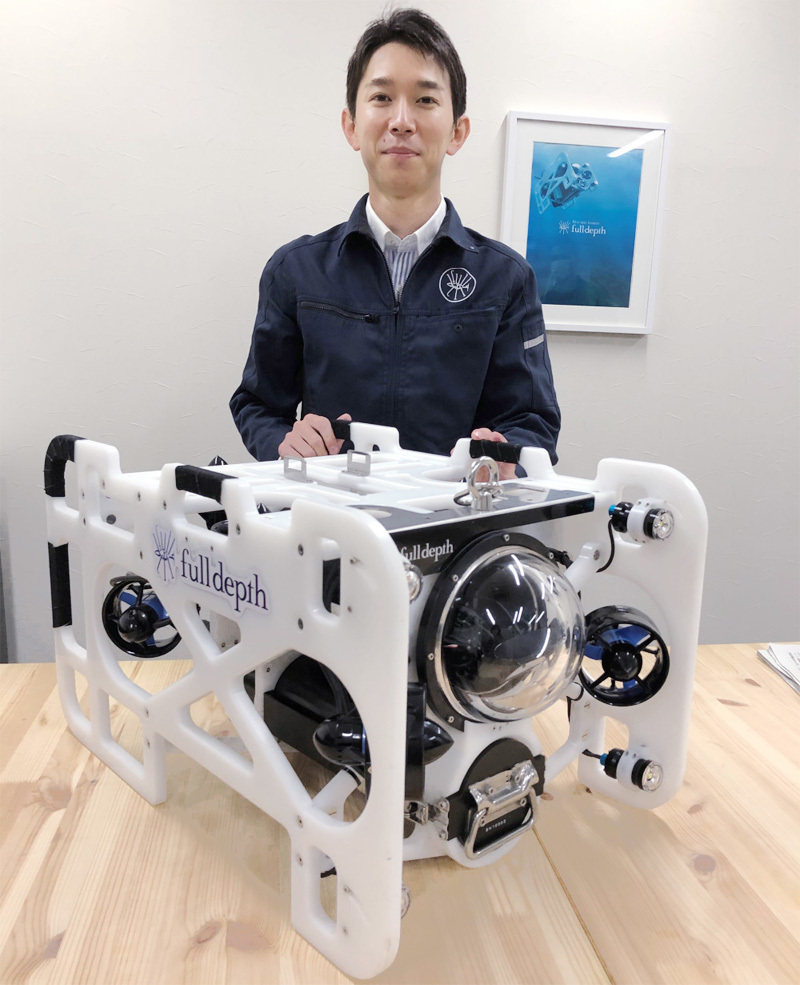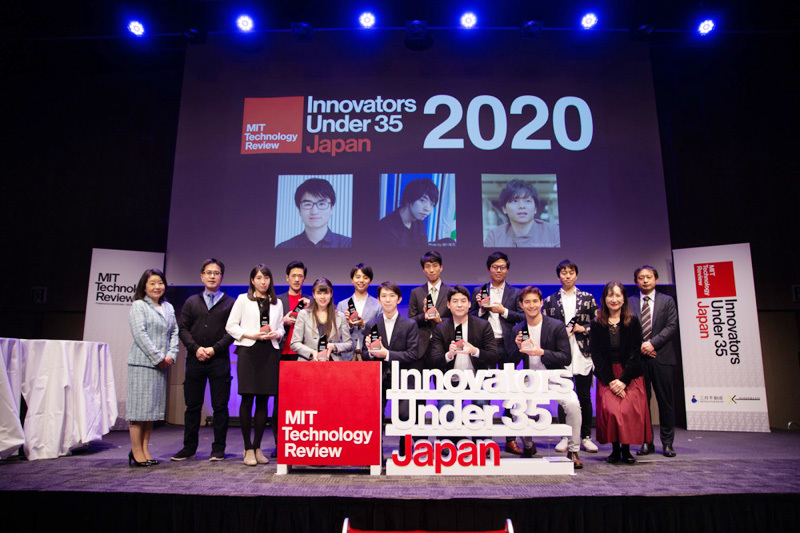
MIT Technology Review, a tech media outlet with over 100 years of history, began as the Massachusetts Institute of Technology's alumni magazine.
This year, the Japanese edition of the magazine is once again hosting the " Innovators Under 35 Japan " award to discover young innovators under 35 who will shape the future.
What does MIT Technology Review expect from Japan's young innovators?
What impact does this award have on applicants and winners?
We spoke with Hisashi Kobayashi, Editor-in-Chief of Kadokawa ASCII Research Institute, which operates the magazine, and Shohei Ito, CEO of FullDepth, one of the winners of the inaugural 2020 award.
(Interviewer: Makoto Sasagawa, Dentsu Inc. Solution Creation Center)
What is the "Innovators Under 35" Award?
・A long-standing award that discovers "young innovators under 35" who will shape the future
・The original (U.S.) award has recognized numerous innovators who later achieved great success, including a young Sergey Brin (Google co-founder) and Mark Zuckerberg (Facebook founder).
・The Japanese edition, launched in 2020, selected 13 young innovators, including our guest Shohei Ito.
Young founders of Google, Facebook, and Twitter also won! A historic award

Sasakawa: I'm delighted to be working with you again on this project, following last year. We'll be speaking with Editor-in-Chief Kobayashi of MIT Technology Review [Japan Edition] about this award's second year. And today, we're also joined by one of the inaugural Japan Edition award winners, CEO Ito , who founded the "underwater drone " startup FullDepth.
Ito: Thank you for this valuable opportunity today.
Sasagawa: Editor Kobayashi, could you first briefly explain the award's overview?
Kobayashi: "Innovators Under 35" is a global award that annually recognizes innovators under 35 who are transforming society through technology.
In the past, it has identified world-leading innovators early on, including Google co-founder Sergey Brin, Facebook's Mark Zuckerberg, and Twitter's Jack Dorsey.
While local editions have been held in various countries and regions around the world, we were able to hold the first Japanese edition in 2020, with 13 individuals receiving awards, including Mr. Ito from Full Depth who is here today. The 2020 awardees will also be nominated for the global edition of the award to be held this summer.
Sasakawa: The application deadline for the second annual awards in 2021 is approaching soon. Are there any major changes from the first edition?
Kobayashi: Yes, starting this year, we've added two new categories: "Energy/Sustainability" and "Communications."
While the global awards originally had nine categories, the Japanese edition started small last year with five categories. This year, we've expanded to seven categories, following a policy of gradual growth.
From the many fields, we selected "Energy/Sustainability" and "Communications" this year as areas we see as high priority challenges Japan should tackle, and where Japan has strong potential to increase its global presence.
Sasakawa: The award's application and judging processes are conducted in the U.S. and around the world. Are the judging criteria the same everywhere?
Kobayashi: Fundamentally, yes. It's a highly objective and clear evaluation system based on globally unified judging criteria. While we can't disclose specifics, key points emphasize the magnitude of the "social impact the technology delivers" over the technology itself, and how clearly the solution to the challenge is communicated.
MIT Technology Review itself is not just a media outlet for tech enthusiasts; it's a publication that pursues "what kind of impact technology has on society." For the awards, "what specific impact that technology or initiative has on society, and what challenges it solves" is a crucial evaluation axis.
* For an overview of the awards, please also refer to our previous article.
"Creating Street View for the Ocean." What is the "Underwater Drone" heading toward this grand dream?

Masahiro Ito, CEO of FullDepth. An "inventor" tackling various social challenges with underwater drones.
Sasagawa: Next, we'll hear from FullDepth CEO Ito, one of the first award recipients. First, could you tell us what kind of company FullDepth is?
Ito: FullDepth is a startup planning, developing, manufacturing, and selling industrial underwater drones, aiming to create an "environment where access to underwater areas is routine."
The primary current applications for our underwater drones are inspections of underwater infrastructure and structures like bridges, dams, ports, and offshore wind farms. Regular inspections are essential for the long-term use of these structures, but diving is dangerous work requiring high expertise, and the shortage of divers is becoming an increasingly serious problem. That's why we provide lightweight underwater drones capable of deep dives to support the maintenance and management of underwater infrastructure.
Additionally, underwater drones are utilized for research into long-term climate change and marine biodiversity, as well as for the development of seabed resources.
Kobayashi: Did applying for and winning the award last year bring any changes to you or the company?
Ito: First, deciding to apply forced us to re-examine "why we are in this business" and "where we should be heading next." I think it was an excellent opportunity.
Sasagawa: Mr. Ito, you originally started building underwater exploration robots as a hobby during your student days, driven by a personal desire to "see deep-sea fish with robots," right?
As you commercialized this, you discovered societal challenges like "aging underwater infrastructure." Now you're tackling issues of such scale that people ask, "Is it really okay to leave such critical societal problems to just one startup?"
Ito: While working on Full Depth, we sometimes heard, "Is there really a market for that?" So receiving recognition from MIT Technology Review brought immense joy – it felt like, "We've been acknowledged!"
Since underwater drones operate in a field demanding "reliability," receiving this global award boosted trust from others and made it easier for us to confidently recommend our own drones.
One more thing: being listed as an "inventor" in the award citation. Actually, in my elementary school graduation yearbook, I wrote "inventor" as my future dream. Having MIT Technology Review officially recognize me as one was an unexpected delight.
In any case, I never imagined we'd receive an award, so I was truly surprised. What aspects do you think were recognized?
Kobayashi: The "ocean" is closely tied to various societal challenges like global warming, marine resource protection, and biodiversity conservation. I believe the high evaluation came from your challenge in the "ocean" and "underwater" domains, which are areas of significant global interest.
Personally, I also sensed that you'll continue to show us "new solutions to social issues using technology," including the fascinating UI of viewing the underwater world through a camera. The ocean is so close to us, yet we know almost nothing about what's actually happening beneath the surface. Discovering correlations between environmental destruction and ecosystems, finding clues to solutions from there—the potential for new discoveries is enormous if we can make underwater drone dives much more frequent.
Ito: For example, regarding microplastic pollution in the ocean, the current reality is that no one truly knows where the acceptable threshold lies or where the real danger begins. I firmly believe that our inability to grasp underwater information will become a bottleneck for humanity's continued existence on Earth.
Earlier, Mr. Sasagawa asked, "Is it really okay to leave this entirely to one startup?" He's absolutely right. We startups inevitably have to start with immediate challenges and areas where we can make an impact right now. But we also need to collectively tackle "long-term, global challenges." Taking this award as an opportunity, I want to work with everyone on such outreach and awareness activities too.
Kobayashi: Furthermore, Mr. Ito has this grand vision of "creating a Street View for the ocean." I believe one reason for his selection is that he presented not just solutions to immediate social problems, but also an exciting future vision of how this could bear fruit in 10 or 20 years.
Ito: I want to make the ocean Street View a reality within my lifetime. Using current technology, it's said it would take 300 years. The challenge is how much we can shorten that 300-year timeline.
While tackling immediate and mid-to-long-term social challenges, my ultimate goal is to create a "Street View" of the entire ocean, accessible to everyone, using full-depth underwater drones.
What do the "Under 35" see that is essential for creating a sustainable future?
Sasagawa: Mr. Kobayashi, as Editor-in-Chief, you've likely observed innovators and researchers across various generations. Since last year, by focusing specifically on those "under 35" through this award, what insights have emerged?
Kobayashi: My impression is that many in this generation place their value standards on "contribution to society" and "social impact" rather than material satisfaction, and are actively thriving within that context.
Moreover, I was deeply impressed anew by how they don't just talk about ideals—they actively launch ventures to implement those ideals in society. Every day since becoming an old man, I feel that they are the ones who will change the world (laughs).
Mr. Ito, while relatively older within the Under 35 category (33 years old at the time of application in 2020), what's your impression of the "under 35" generation?
Ito: I think there are at least no barriers to "starting a business." I myself started a business without any hesitation, so I imagine this tendency is even more pronounced among generations younger than me.
At the same time, more companies in recent years are supporting employees' side hustles, dual employment, or starting their own businesses. I think it's truly positive that Japanese society is shifting toward an environment that makes it easier to take on challenges.
Kobayashi: One goal of the awards is to create "chemical reactions" through encounters between winners. Did you connect with any other winners from your generation?
Ito: Yes, personally, the most stimulating part this time was simply the fact that "I'm standing on the same stage as these incredibly talented people" (laughs). I had known Tomohiro Fukuzawa from SkyDrive and Sho Nakanose from G-Tie before, and since we share common ground in running hardware-focused businesses, exchanging information with them was very meaningful.
Kobayashi: Due to the pandemic, opportunities for interaction were fewer than originally planned, but I'm glad to hear that. The 2020 winners came from quite diverse backgrounds. Diversity is a crucial point for this award. We actively encourage applications not only from those tackling global challenges, but also from anyone who feels discomfort or recognizes issues with specific aspects of society and is working to solve them using technology.
By hosting this award, we seek "young innovators building a sustainable future world." We believe that when strong minds and convictions come together, society becomes more dynamic. Therefore, we would be delighted to see broad participation, not just based on whether the technology is outstanding.
Ito: That's absolutely crucial. We've built our work step by step, often facing questions like "Is that really meaningful?" The recognition from MIT Technology Review through this award has given our entire team tremendous confidence and energized us to share our efforts with the world.
I'm not in a position to sound too grand, but if you believe in something, I really encourage you to apply for the award. Just applying itself is a big challenge, I think.
Sasagawa: I'm already looking forward to learning about the initiatives of Japan's young innovators this year. Thank you for your time today!
The application deadline for "Innovators Under 35 Japan 2021" is August 31, 2021. We look forward to receiving applications from everyone challenging themselves to create a sustainable future. For application guidelines, the application form, and other details, please visit the official website!
















